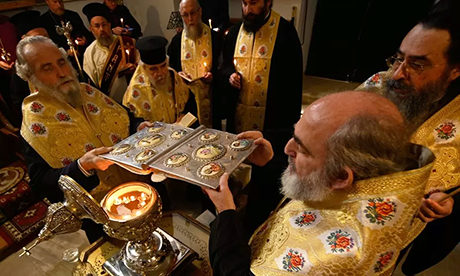The oil that will be used to anoint King Charles III during his coronation has been consecrated by senior clergymen in Jerusalem.
The oil was pressed from olives harvested on the Mount of Olives, and has been perfumed with sesame, rose, jasmine, cinnamon, neroli, benzoin, amber oil and orange blossoms.
The ceremony was conducted by His Beatitude Patriarch Theophilos III, head of the Greek Orthodox Church in Jerusalem, and the Most Rev Hosam Naoum, the Anglican archbishop in Jerusalem.
The ritual was held at the Church of the Holy Sepulchre, the traditional site of Christ’s crucifixion and burial.
Reflecting modern animal-friendly sensitivities, the oil used to anoint the King will not include any ingredients from animals. Previous versions have included civet oil and ambergris from the intestines of whales.
The anointing of the King has echoes of a christening or the ordination into religious orders, with the monarch being symbolically touched with holy oil on the head, chest and hands.
However, this was considered such a sacred moment that television cameras were prohibited from filming it in 1953.
There has been speculation about whether the anointing will be shown on TV during the coronation of King Charles III.
Deep historic links
The oil has a royal family significance, partly using olives grown on the Mount of Olives at the Monastery of Mary Magdalene, where the King’s grandmother, Princess Alice, is buried.
In his Christmas message, the King spoke of his own Christian faith and how much he had been moved when he visited biblical sites, such as Jesus’ birthplace in Bethlehem.
The Archbishop of Canterbury, Justin Welby, welcomed the use of oil from the Mount of Olives, a site outside Jerusalem with many biblical connections.
“This demonstrates the deep historic link between the coronation, the Bible and the Holy Land,” said the archbishop. “From ancient kings through to the present day, monarchs have been anointed with oil from this sacred place.”
The implements used for the anointing, including a spoon, are rare survivors of the original medieval coronation regalia, most of which were destroyed on the orders of Oliver Cromwell in 1649.
Charles will be formally crowned on 6 May at Westminster Abbey in London during a ceremony combining elements of tradition with modern touches that highlight the changing face of the United Kingdom and the Commonwealth.
Sources
Additional readingNews category: World.




